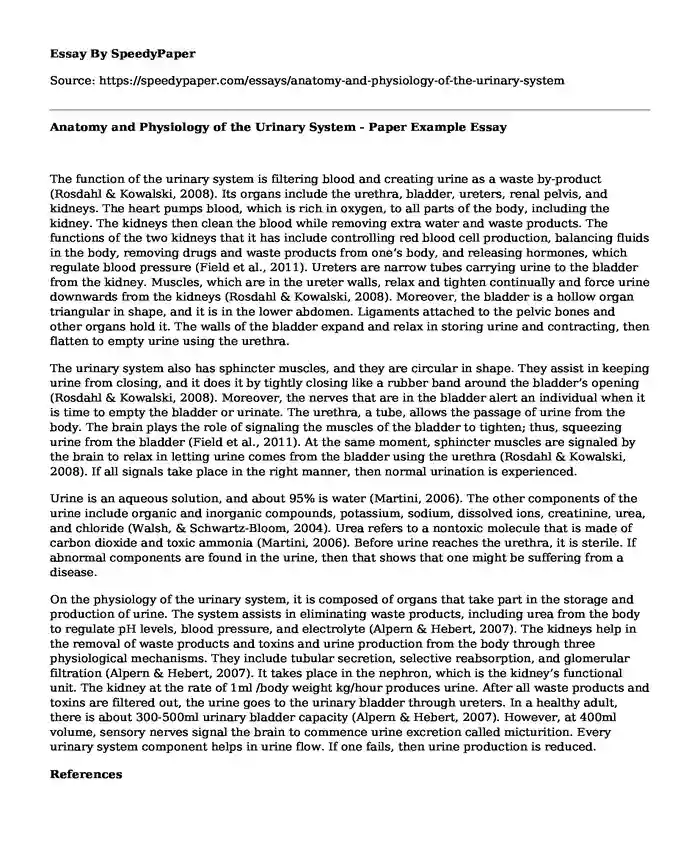The function of the urinary system is filtering blood and creating urine as a waste by-product (Rosdahl & Kowalski, 2008). Its organs include the urethra, bladder, ureters, renal pelvis, and kidneys. The heart pumps blood, which is rich in oxygen, to all parts of the body, including the kidney. The kidneys then clean the blood while removing extra water and waste products. The functions of the two kidneys that it has include controlling red blood cell production, balancing fluids in the body, removing drugs and waste products from one’s body, and releasing hormones, which regulate blood pressure (Field et al., 2011). Ureters are narrow tubes carrying urine to the bladder from the kidney. Muscles, which are in the ureter walls, relax and tighten continually and force urine downwards from the kidneys (Rosdahl & Kowalski, 2008). Moreover, the bladder is a hollow organ triangular in shape, and it is in the lower abdomen. Ligaments attached to the pelvic bones and other organs hold it. The walls of the bladder expand and relax in storing urine and contracting, then flatten to empty urine using the urethra.
The urinary system also has sphincter muscles, and they are circular in shape. They assist in keeping urine from closing, and it does it by tightly closing like a rubber band around the bladder’s opening (Rosdahl & Kowalski, 2008). Moreover, the nerves that are in the bladder alert an individual when it is time to empty the bladder or urinate. The urethra, a tube, allows the passage of urine from the body. The brain plays the role of signaling the muscles of the bladder to tighten; thus, squeezing urine from the bladder (Field et al., 2011). At the same moment, sphincter muscles are signaled by the brain to relax in letting urine comes from the bladder using the urethra (Rosdahl & Kowalski, 2008). If all signals take place in the right manner, then normal urination is experienced.
Urine is an aqueous solution, and about 95% is water (Martini, 2006). The other components of the urine include organic and inorganic compounds, potassium, sodium, dissolved ions, creatinine, urea, and chloride (Walsh, & Schwartz-Bloom, 2004). Urea refers to a nontoxic molecule that is made of carbon dioxide and toxic ammonia (Martini, 2006). Before urine reaches the urethra, it is sterile. If abnormal components are found in the urine, then that shows that one might be suffering from a disease.
On the physiology of the urinary system, it is composed of organs that take part in the storage and production of urine. The system assists in eliminating waste products, including urea from the body to regulate pH levels, blood pressure, and electrolyte (Alpern & Hebert, 2007). The kidneys help in the removal of waste products and toxins and urine production from the body through three physiological mechanisms. They include tubular secretion, selective reabsorption, and glomerular filtration (Alpern & Hebert, 2007). It takes place in the nephron, which is the kidney’s functional unit. The kidney at the rate of 1ml /body weight kg/hour produces urine. After all waste products and toxins are filtered out, the urine goes to the urinary bladder through ureters. In a healthy adult, there is about 300-500ml urinary bladder capacity (Alpern & Hebert, 2007). However, at 400ml volume, sensory nerves signal the brain to commence urine excretion called micturition. Every urinary system component helps in urine flow. If one fails, then urine production is reduced.
References
Alpern, R. J., & Hebert, S. C. (2007). Seldin and Giebisch’s The Kidney: Physiology & Pathophysiology 1-2. Burlington: Elsevier Science.
Martini, F. (2006). Anatomy and Physiology’2007 Ed. Rex Bookstore, Inc.
Rosdahl, C. B., & Kowalski, M. T. (2008). Textbook of basic nursing. Philadelphia: Lippincott Williams & Wilkins.
Walsh, C. T., & Schwartz-Bloom, R. D. (2004). Pharmacology: Drug actions and reactions. CRC Press.
Cite this page
Anatomy and Physiology of the Urinary System - Paper Example. (2024, Jan 28). Retrieved from https://speedypaper.com/essays/anatomy-and-physiology-of-the-urinary-system
Request Removal
If you are the original author of this essay and no longer wish to have it published on the SpeedyPaper website, please click below to request its removal:
- Introduction of Pluripotent Stem Cells - a Summary Paper Example for Free
- Free Essay on How Physics Is Related to Our Real Life
- Paper Example. Open Banking Application Programming Interface in Hongkong
- Classical Conditioning: Pavlov & Stimulus-Response Theory - Essay Sample
- Paper Example. Nursing: Culture and Cultural Safety
- Determinants of Health Using Blum's Model - Free Paper Example
- Allopatric and Sympatric Speciation - Paper Example
Popular categories





